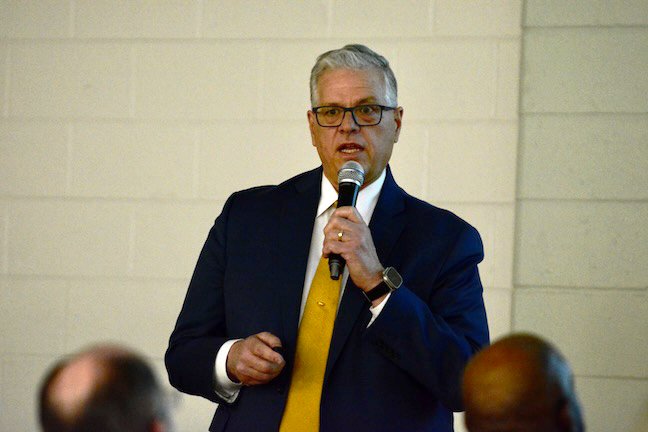
An additional $11 million in spending for Fiscal Year 2026 approved April 10 by the Board of Education will allow the reinstatement of many line items that had previously been cut from the proposed FY 2026 budget, the district’s top official said.
The $11 million would mitigate the $6 million that the Board had to cut in its preliminary budget, introduced last month, plus assorted health care costs, schools Superintendent John Ravally said.
Line items such as high school deans, after-school bussing and filling vacant positions, among many others, would be restored if the District’s plan is approved by the state Department of Education Commissioner, Ravally told the Board.
With the additional spending, the total schools portion tax impact on the owner of a residential property assessed at $555,000 – the township average – would increase by about $675 a year over the FY 2025 spending plan, Ravally said.
A final vote on the proposed FY 2026 budget is set for the Board’s April 24 meeting.
School districts are limited to general purpose budget increases of 2 percent year-to-year. In prior years, any shortfalls would usually be made up by state aid.
But the state changed that dynamic about three years ago, starting a three-year phased-in program that would put more of the onus on districts providing the necessary funding for a “thorough and efficient” education on the districts themselves, through taxation.
State aid is still available, but it is distributed in different ways.
To make up for the change in state aid disbursement, districts that meet certain criteria this year are allowed to submit Applications for Additional District Expenditure.
Franklin meets those criteria, Ravally told the Board.
The three variables that affect a district’s ability to apply for the additional spending are called local fair share, spending to adequacy, and state aid cuts, he said.
Local fair share, Ravally said, is “really a calculation of the amount the Department of Education determines should be supported by tax levy in a given school district’s town. It’s the same across the entire state for all public schools.”
“In our case, the determination … based on property wealth and average income … is our fair share, meaning the share that we should be levying of the total school budget, or the part of the budget that should be dependent upon tax revenue, is $200,463,475, so a little over $200 million,” he said. “The current year budget, the tax levy, is $162,114,985.”
“So, in the Department of Education’s world, we are currently operating below what they determine to be local fair share,” he said. “So, that checks a box, and not a good box for us.”
Spending adequacy, Ravally said, is a per-pupil figure the state DOE believes “based on the economy, based on what things cost, what it would cost to educate a child. They call that a base number.”
“They take that base number, and then they adjust it by the diversity of your population,” he said. “A multilingual student requires more supports, so they expect a little additional spending. They expect some more costs associated with educating a special education student, so that adds to the spending. An at-risk student, which is a student who might fall below the poverty line, that, in the state’s terminology, is called an at-risk student … would then, again, add to the per-pupil base cost. And then they come up with what they say should be an adequate amount of spending on your students.”
“For us, given the size of our district, the variation in the population, adequate spending, according to the New Jersey Department of Education, would be $208 million, roughly,” Ravally said.
“Our current year adequacy spending is $180 million,” he said. “So, we’re spending below what the state determines to be adequate to educate the population of students that we have.”
Rather than send state aid to correct the situation, as was done in the past, the state now is “going to give you the ability to raise tax, to get to adequacy,” he said.
The application is reviewed by the DOE commissioner “to make sure the areas in which you’re putting that additional spending directly relate to the academic budget,” he said.
During the years in which the district “sailed along” with the 2 percent cap in spending increases “the variation in our population has changed over time, so that we’re increasing in the number of special education students that we’re educating, we’re increasing in the number of multilingual students, we’re increasing in the number of at-risk students that we’re educating, the adequacy spending limit continues to rise,” he said. “So, you’re going along, and then you also have on top of that all the inflationary costs on those supplies as well, and you can see how you can quickly get a discrepancy in adequacy spending, especially when you’re getting cuts in state aid because it’s only making it tougher to spend.”
“Our only way to push toward adequacy unfortunately is to raise taxation,” he said. “That’s the problem. It wasn’t like that a few years back. There was adjustment aid, equalization aid.”
Ravally noted that the District could have applied to make up for the entire $28 million “below adequacy” gap, but chose not to.
“We’re leaving a lot of money on the table,” he said. “And yes, we’re still going to be below adequacy. The state would tell us you could spend more. We understand the circumstances … but we have to balance that with the needs of our kids.”
“We’re not asking for an amount more than we need to restore programs to what they are currently,” he said. “Absent that money, we lose these things. And there’s no way around it.”
Programs that were looking to be cut under the proposed budget adopted by the school board on March 18 were:
- Eliminating after-school busing
- Eliminating Saturday detention
- Eliminating Peer and Positive Impact Mentoring programs while looking for grant funding
- Reliance on services provided by vendors will be reduced, and certain services will be brought in-house
- Reductions in consumable materials, such as paper
- In the athletic department, cutting bus routes and eliminating some coaching positions
- Reducing the Road to Success program to four hours daily from six hours
Among the staff cuts were:
- Reducing certificated staff positions, with fewer academic instructional coaches, academic interventionists, and administrative support personnel
- Reducing non-certificated staff positions, with fewer safety personnel and custodians.
Not everything can be restored, Ravally said.
“We’re restoring content in school area budgets, but not to what they were this year,” he said. “There’s still a good 15 percent off of those budgets.”
“So there will still be less paper,” he said. “There still will be less pencils, and of course, you know, lots of other things, but I’m using those as examples. And there’s other efficiencies that are non-academic, meaning administrative efficiencies, there’ll be less administration, there’ll be less legal expenses, and we have other contributions that we’re tightening up on, our pension contributions, and we’re taking everything down to the wire because we recognize, the board recognizes, the finance community recognizes, that anything that we now try and support, we have to support with levy.”
“This is probably the worst of all possible scenarios, which is another reason why the recommendation isn’t to get anywhere near that $28 million, but instead just restore what we’ll have to lose,” he said.
Board members had clarification questions, but all eventually voted “yes,” save for Nick DiMeglio, who abstained due to a conflict.
Stay ‘In the Know,’ subscribe to the Franklin Reporter & Advocate!
No other media outlet covering Franklin Township brings you the depth of information presented by the Franklin Reporter & Advocate. Period. We are the only truly independent media serving the Eight Villages.
But we can only do that with your support. Please consider a yearly subscription to our online news site; at $37 a year, it’s one of the best investments you can make for yourself.
To subscribe, please click here.
 The Franklin Reporter & Advocate Eight Villages, One Community
The Franklin Reporter & Advocate Eight Villages, One Community

